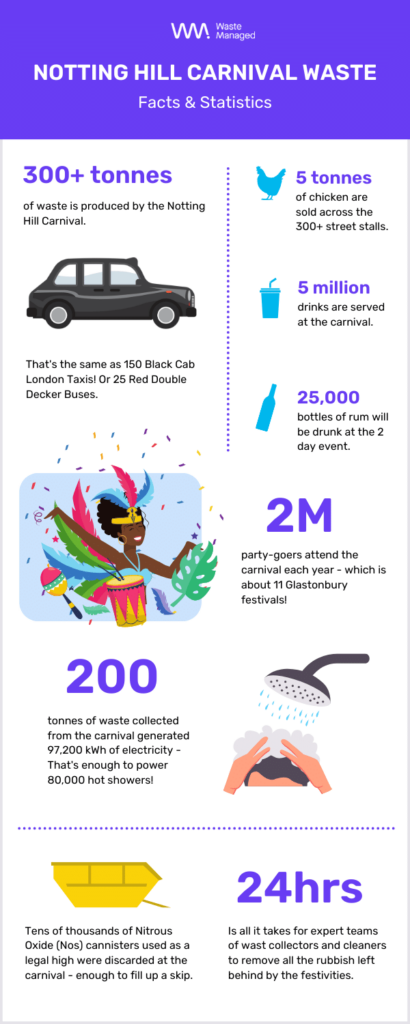
London’s vibrant cultural scene is renowned worldwide, and one of the city’s most anticipated events is the 2023 Notting Hill Carnival.
Taking place on the August 27th – 28th bank holiday, each year, millions of revellers flock to the streets of West London to celebrate Caribbean culture, music, and tradition.
However, this extravagant and colourful celebration can also lead to a significant amount of waste.
As environmental concerns become increasingly prominent, it’s important to address the issue of waste and adopt sustainable practices to reduce the carnival’s ecological footprint.
Notting Hill Waste Facts and Statistics 2023
- Around 300 tonnes of waste is produced by the Notting Hill Carnival – the same as 150 London Taxis!
- Around 2 million party-goers attend the carnival each year – which is about 11 Glastonbury festivals!
- There are over 300 food stalls and 38 live sound systems to support the 72 Masquerade bands, 11 steelpan bands, and 100 live stage acts, each causing a significant amount of waste even without spectators.
- The 300+ food stalls on the streets serve 5 tonnes of chicken, 30,000 corn on the cobs and 1 tonne of rice and peas
- Over 5 million drinks are served at the carnival, including 25,000 bottles of rum! That’s a lot of glass and plastic waste.
- Last year, 200 tonnes of waste collected from the carnival generated around 97,200 kWh of electricity – That’s enough to power 80,000 hot showers and 54 tonnes of carbon emissions saved by avoiding landfill.
- Tens of thousands of canisters of legal high, Nitrous Oxide, aka hippie crack, nos, or balloons, are scattered on the streets at the festival. Last year an entire skip was filled with them.

What Happens to Waste at the Notting Hill Carnival
As soon as the carnival wraps up and the partygoers start heading home, a crew of 170 waste collectors, backed up by 60 handy machines, swoops in to clean up the mess.
These folks work tirelessly through the night, making sure the streets are spick and span for all the early bird commuters on Tuesday morning.
They’ve got two big goals: clearing out the bus routes so things flow smoothly and getting the markets on Portobello Road and Golborne Road ready for action.
By lunchtime on Tuesday, you won’t even know a wild carnival happened there.
By Thursday, the entire place has to shine, meeting the strict standards set by the Environmental Protection Act.
They use cool machines to clean the gutters and high-power jets to scrub the sidewalks spotless.
If there are any greasy or oily spots causing trouble, the street cleaners are on the case.
How to Reduce Waste at the 2023 Notting Hill Carnival
There are lots of ways to reduce waste at this year’s event such as:
Embracing Eco-Friendly Packaging
One of the primary contributors to waste during the Notting Hill Carnival is single-use plastic packaging.
From food vendors to beverage stalls, countless items are served in disposable containers that end up in landfills or, even worse, litter the streets and surrounding areas.
By encouraging vendors to use biodegradable or compostable materials for packaging, we can significantly reduce the environmental impact of the event.

Implementing Effective Waste Management
The sheer size of the carnival makes waste management a considerable challenge.
However, with proper planning and organisation, waste bins can be strategically placed throughout the carnival route can help attendees dispose of their waste responsibly.
Temporary bins are a necessity to keep rubbish off the streets at an event like this.
Promoting Recycling and Upcycling Initiatives
Encouraging carnival-goers to actively participate in recycling efforts can significantly contribute to waste reduction.
By setting up recycling stations and providing clear instructions on what can be recycled, attendees can be motivated to do their part in keeping the carnival clean and green.
Additionally, the Notting Hill Carnival organisers can collaborate with local artisans and organisations to upcycle some of the discarded materials into beautiful souvenirs or artworks, giving waste a new life.
Educating Attendees on Sustainable Practices
Awareness plays a crucial role in any environmental initiative.
Organisers of the Notting Hill Carnival can actively promote sustainable practices and eco-friendly behaviours among the attendees.
Using social media, flyers, and announcements throughout the event, information about waste reduction, recycling, and other environmentally friendly practices can be shared with the public.
Supporting Community Cleanup Efforts
The Notting Hill Carnival is not just a one-day event; it’s a representation of the vibrant and diverse community in the area.
By organising community cleanup days before and after the carnival, locals can come together to tidy up the streets and neighbourhoods affected by the festivities.
These cleanup efforts instil a sense of ownership and responsibility, encouraging everyone to maintain the beauty of their community.

Exploring Alternative Energy Sources
With thousands of visitors attending the carnival each year, energy demands can be significant.
Exploring the use of renewable energy sources like solar panels and efficient generators can help reduce the event’s carbon footprint.
By transitioning to cleaner energy sources, the carnival can take a step towards becoming more sustainable.
Conclusion
The Notting Hill Carnival is a celebration of culture, diversity, and unity.
As we revel in this colourful event, it is crucial to remember the impact it can have on the environment.
By adopting sustainable practices, embracing eco-friendly packaging, and promoting waste reduction and recycling initiatives, we can preserve the essence of this carnival while reducing its environmental impact.
Together, we can ensure that future generations can continue to enjoy the spirit of the Notting Hill Carnival, while also preserving the beauty of London and the planet we all share.








